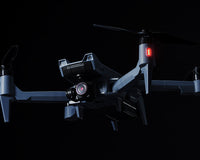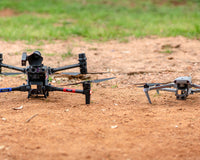Are you sold on onboarding drones into your public safety operations but wondering where to begin?
There's no doubt that Unmanned Aerial Systems (UAS) have made a mark in law enforcement and continue doing so, which has consequentially led to their increased use, particularly in police departments.
Currently, more than 1200 police departments in the U.S.A. have embraced drone use into their operations.
A lot goes into setting up a drone program, but it's worthwhile as you'll reap maximum benefits in due time. These benefits manifest as increased efficiency, productivity, enhanced safety, and so much more.
However, for all these benefits to materialize, you'll need to be strategic about it, and part of that involves complying with the Federal Aviation Administration's (FAA) guidelines and regulations.
Let's get right into it.
Step 1: Construct An Outline of Your Missions' Objectives
Drafting a plan is the first and most important step.
There are tons of ways for law enforcement officers to integrate UAV technology into their operations. Some include search and rescue operations, firefighting, disaster, and event management.
Here's an article that clearly dissects more of these use cases and also cites a real-life example: Here's Why You Need to Start a Drone Program for Your Public Safety Agency
Hence, laying out the intended end goals for your aerial operations is imperative. A strategic plan should roughly factor in:
- How external environmental factors may affect drone deployment.
- Size of your area of jurisdiction.
- The aircraft's 'scope of work' and if it's in line with local and state regulations.
- Aerial operations' complexities.
- Your budget.
- The supplementary resources that are available to fund your drone program.
Planning your aerial operations gets you to see the bigger picture, thus, consequentially aiding you in determining which FAA regulations are the most suitable for your drone program to work under, the best UAV model to invest in, and the best training approach for your UAS team.
After defining your mission's priorities, letting them be known to your local community should be the next step—more on why this is beneficial in the next section.

Step 2: Initiate A Community Outreach Program
Privacy and safety concerns are the biggest bone of contention for the local community. You can easily quash these concerns by making time to create awareness in your local community and, while at it, include the local stakeholders.
Where one-on-one sit-downs are ineffective, you and your team should leverage social media as a tool to access a wider population of your community, and to organize virtual meetings to address their privacy concerns.
Let them know your department's drone policies and their importance in law enforcement operations. The goal is to get them to understand that onboarding drone technology is meant to work for them rather than against them.
It's best to start your community engagement program before starting your aerial operations. Don't forget to maintain the same energy even after your operations have begun. Also, regularly obtaining feedback from your local community and stakeholders is key and helps you to gauge the progress of your outreach programs.
Consulting other police departments that have run successful drone programs for ways to keep your community actively engaged with drone operations is a step in the right direction.
Any relationship set up on good values yields good things, and in this instance, you may yield goodwill which may ultimately translate to funding for your drone program.
Playing the long game is never fun, but it sets you up for long-term success.
Step 3: Do A Thorough Cost-benefit Analysis
Unlike manned aircraft, unmanned aircraft are way more cost-effective as they don't require fuel. Besides saving your department's money, UAVs save lives too! Additionally, a manned aircraft's malfunction is more detrimental than a drone's, as lives may be lost.
An extensive cost-benefit analysis factors in the cost of:
- Drone equipment - how much do the type of payloads you need for your use cases cost?
- Pilots - will you need to outsource more staff for separate pilot roles?
- Insurance coverage- which insurance optionss are suitable for your drone program?
- Training - how many people will be on your sUAS team, and what are the costs to equip them with operational skills?
- Compliance system - involves keeping a record of your flight logs in the event of an incident such as an accident.
- Administration - you may need an administrator to keep tabs on your pilots' certificates and other documentation such as maintenance, insurance, safety, and much more.
These considerations will also come in handy when setting up a budget, and to help determine whether or not you need additional funding.
Law enforcement agencies utilize military surplus transfers, federal grants, civil asset forfeiture money, and other sources to support their drone programs financially.
Your local community may also come through for you through the key stakeholders in your area's private and corporate foundations.
Step 4: Make A Choice
Remember to work with your budget, your program's priorities, and other non-negotiable features such as geofencing capabilities, camera quality, LiDAR capabilities, ease of deployment, and others.
The market is saturated with many off-the-rack and foreign UAS systems in varying sizes and prices for different use cases. The choice is entirely yours to make.
For starters, you can opt for a sub-250 grams drone to acclimatize your UAS team and finally go all-in once the training is completed. For instance, the DJI Mini 2 is jam-packed with impressive technology and still affordably priced at $449.
At that price, it's an absolute steal!
If you are more inclined toward obtaining a heavy-duty quadcopter with incredible camera quality and obstacle avoidance, then the DJI Matrice 300 RTK is for you.
Also, if your area of jurisdiction's airspace is controlled, you might want to look into tethered UAVs. Speaking of restrictions, are you aware that the FAA requires you to select rules under which your drone program will mostly thrive?
We dissect this in the next section.
Step 5: Select Which FAA Rules to Operate Under
The FAA has established two ways to operate the drone program that provides you with the option of flying under:
Part 107- Civil Aircraft Operations
After rigorous training and passing an examination, a Remote Pilot Certificate is issued. Part 107 equips your team with hands-on knowledge and skills to operate sUAS and seamlessly navigate a flight.
However, despite offering an extensive training program, Part 107 has the following operational limitations:
- Nighttime flight restrictions- only daytime flights are allowed.
- Flying beyond the visual line of sight is restricted.
- Flying beyond 400 feet above ground level isn't allowed.
- Flying in Class B, C, D, and E, airspace is restricted.
- Maximum take-off weight is capped at 55 lbs.
Part 107 waivers are available during emergencies for the following operations:
- Night time operations
- Crowd management
- Flights in Class B, C, D, and E airspace.
- Simultaneous drone flights.
- Flight operations that can go beyond the visual line of sight.
- Flights in controlled airspaces.
- Flights above 400 feet.
Part 91 COA- Public Aircraft Operations
A COA(Certificate of Authorization) offers more flexibility, but at what cost? The catch is that the application and verification process takes longer than it would take to obtain a Part 107 Remote Pilot Certificate.
The waiting period is about 60 days.
The COA application process involves:
- Drafting a public declaration letter.
- Access the CAPS online program.
- Prepare all the necessary documentation with a few of these, including a lost-link and lost communication procedure for your aircraft and others.
- Complete the online application process.
Before submitting your application, you must ensure that your law enforcement agency meets the public aircraft operations criteria.
Are your missions typical activities that the government solely undertakes? Do you own or have a lease agreement for the aircraft you intend to operate under this rule?
These are a few critical questions you should ask yourself before choosing to fly under FAA's COA.
After its approval, you get to:
- Fly in regions of controlled airspace where applicable.
- Fly over a public crowd while observing all safety measures.
- Perform operations during the night without needing special permissions.
Under the COA, law enforcement departments can design training programs, but the FAA still recommends that all public aircraft operators have a Remote Pilot Certificate.

Step 6: Set Up Your UAS Team
Do you run a small, mid-size, or small law enforcement agency? The size of your agency is an important factor that helps you determine how to set up your drone team.
So, will you pick members from your team to train or employ new members solely as UAV pilots? Well, that's for your budget to dictate.
Remember that a successful drone program trains enough personnel.
Step 7: Train Your UAS Team
A successful drone program is not dictated by the number of staff members that have undergone training, but by the quality of the training program.
Your choice of the rule to operate under also dictates the trajectory of your training program. You can do training in-house or through external assistance, or you can opt to combine the two.
A few vital training topics include:
- Aircraft selection for your missions.
- Crisis handling.
- Airworthiness assessment.
Other than pilots, you'll also need visual observers, maintenance officers, and safety officers who adequately provide the drone pilot with situational awareness during a flight. Visual observers also need to undergo training.
A good law enforcement UAV program should offer refresher courses to stay up-to-date with FAA guidelines.
Step 8: Formulate An Internal Policy
Borrowing a leaf from the books of other law enforcement departments that have been in the game for a while will help you develop a solid internal policy.
Internal policies primarily highlight the job descriptions for the various roles in your UAS team, a mission statement, deployment procedures and protocols, fleet and flight log management, and much more.
It's important to have a well-polished internal policy to avoid rewriting. Besides that, you also run the risk of having a failed sUAS program.
Once drafted, it may be best to share it with your local community. So take your time, and don't forget to consult your peers and experts.
Next Steps
A cocktail of procedures goes into launching a UAV program for your law enforcement agency. If you seek clarification on any of the highlighted steps, don't hesitate to contact Advexure for a more detailed explanation.
Are you worried about obtaining funds to acquire that ideal drone you’ve been eyeing? We’ve got you! You can get your desired drone equipment and more through our drone financing program, which allows you to spread your payments over months.
At Advexure, we strive to provide you with an excellent customer experience. Our UAS experts have tried out and tested our aircraft to ensure you have a seamless flight experience.
Advexure's demo and leasing program allows your UAS team to acclimatize itself to drone technology for an agreed period. Are you ready to work with us to establish which drone works best for your mission requirements?
Connect with us to get your risk-free quote, or just open the chat box for strategic advice on the best drones for your law enforcement agency in your jurisdiction.










